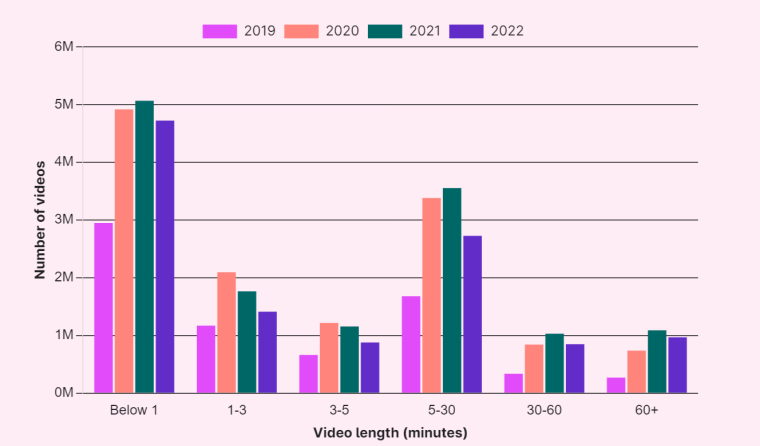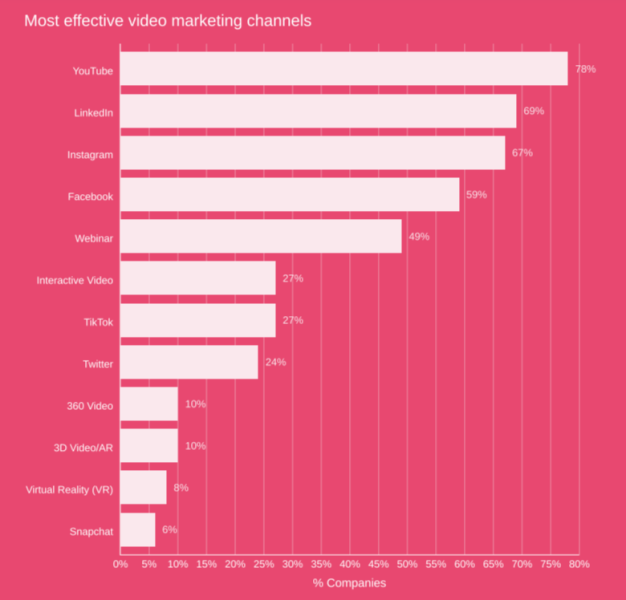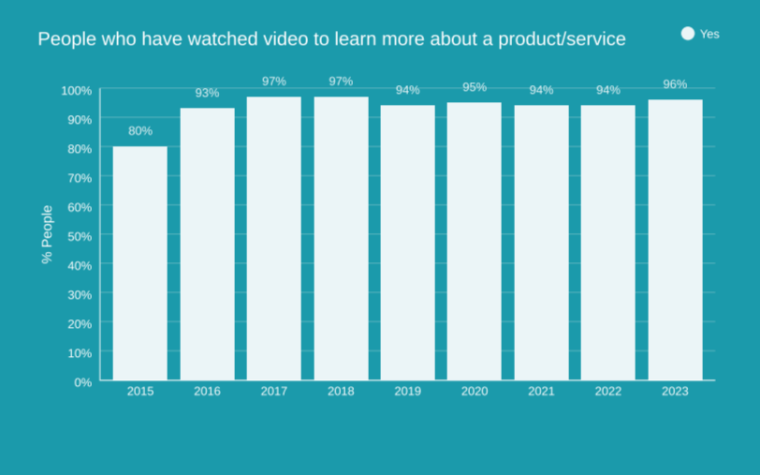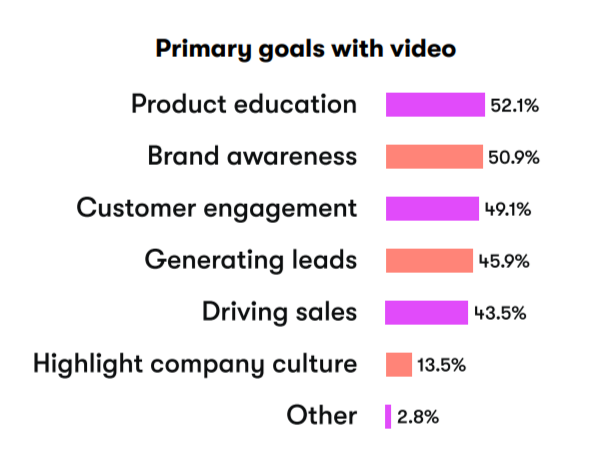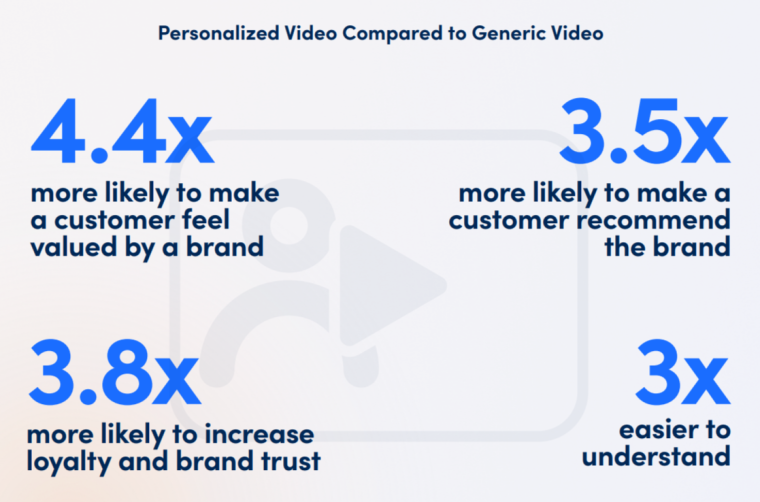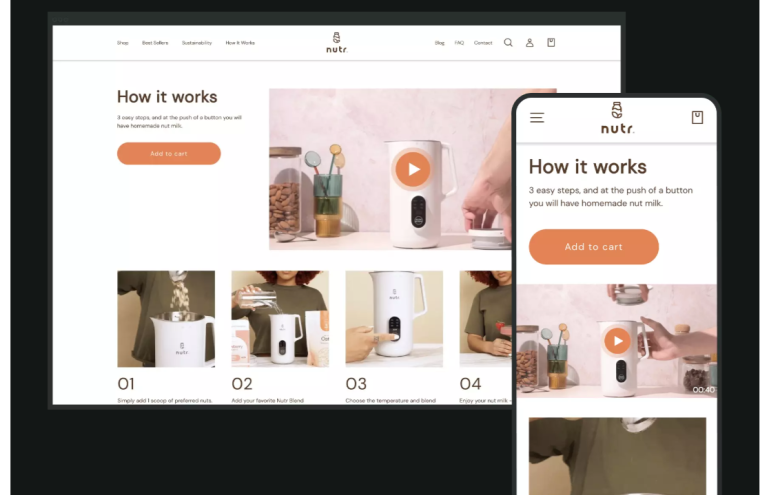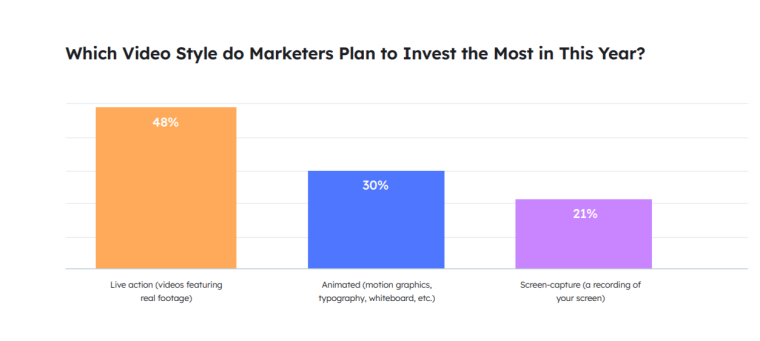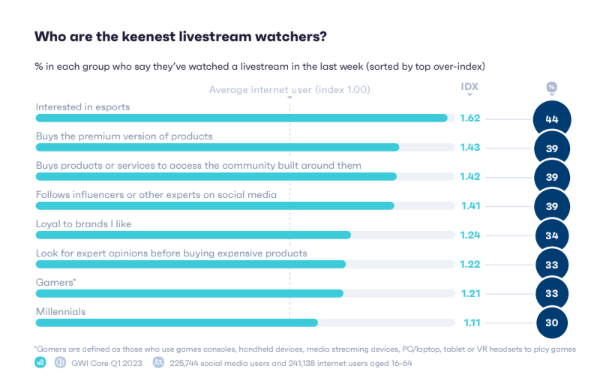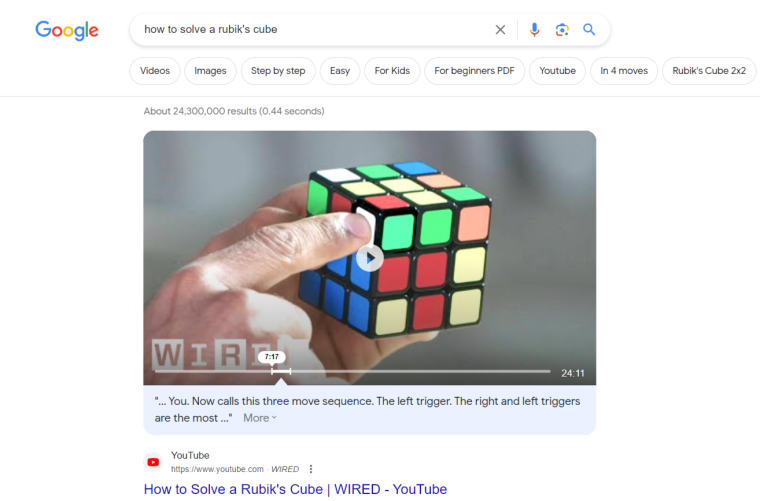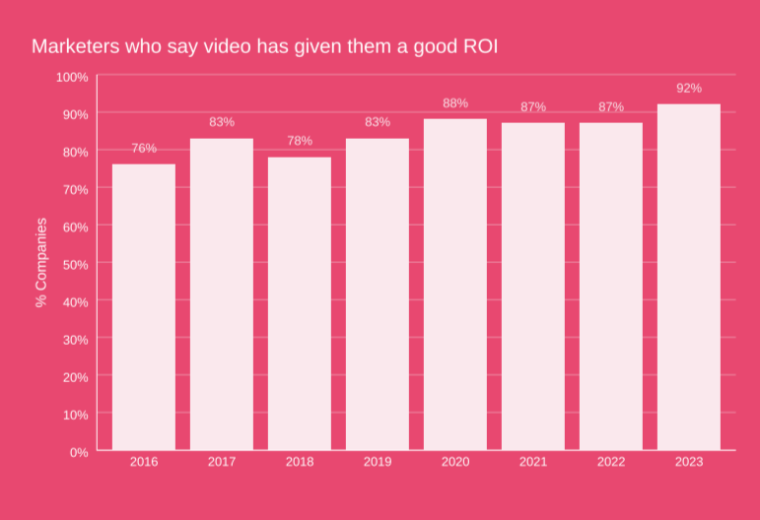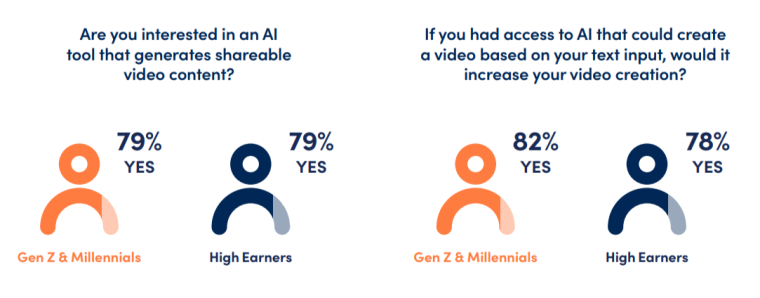Brands, creators, and businesses create video content to educate their audiences, increase brand awareness, and generate leads. With all the algorithm changes, content types, and different social media platforms, following the latest video marketing trends in 2025 is crucial to see the best possible ROI with video.
At Business2Community, we’ve compiled a list of the top video marketing trends to watch in 2025, through industry reports, statistics, expert insights, and case studies.
Key Video Marketing Trends
- 83% of marketers agreed that the best length for short-form videos is less than 60 seconds.
- In 2023, 96% of people had watched an explainer video to learn more about a product.
- Over half of companies use videos for product education and brand awareness.
- For 49% of marketers, live-action videos are more likely to go viral than other types of videos.
- 68% of marketers track engagement metrics such as views, view rate, and average watch time to understand video performance.
What are 2025’s Video Marketing Trends?
In 2023, 91% of businesses said they used video as a marketing tool. Similarly, 75% of B2B content marketing professionals also used videos as a part of their marketing strategy. Yet, 81% of consumers still said they want to see more video content from brands.
As the demand for video soars, especially among the younger generation, brands can make a difference by following the latest trends in the video marketing world while staying authentic.
Here are 14 video marketing trends to look out for in 2025:
1. Video Length is Vital
Short-form videos are trending, especially with YouTube Shorts, Instagram Reels, and TikTok boosting short videos. However, in 2025, long-form videos were also popular for educational content, interviews, and tutorials.
According to a survey by the video marketing company Wistia, two specific video lengths stood out in 2022:
- Short-form videos under 60 seconds.
- Longer videos between five and 30 minutes.
Short-form videos engage audiences with short attention spans. It’s easy to watch them until the end, which boosts viewer engagement. 83% of marketers agree that the best length for short-form videos is less than 60 seconds.
Long-form videos are those that last more than three minutes. While videos between five and 30 minutes were the most popular long videos in 2022, the fastest-growing segment was videos over 30 minutes, including live videos, how-to content, and webinars. Businesses reported that these videos performed well and led to high conversion rates.
2. The Best Social Media Platforms Depends on Your Audience
When it comes to the most effective video channels, 78% of marketers preferred YouTube, 69% LinkedIn, 67% Instagram, and 59% Facebook, suggesting that social media is key for video marketing and distribution in 2025.
There isn’t a simple answer to which platform is best for a video marketing campaign, as various social media sites cater to different content types. To understand what worked best on each platform, PlayPlay reviewed 5,000 posts from Facebook, Instagram, LinkedIn, Twitter, YouTube, and TikTok from 2022 to 2023.
Here are the key insights from its Video & Social Media 2023 Report:
- Facebook: Users enjoy seeing entertaining videos. Videos repurposed from Instagram Reels or stories also perform well, as both Instagram and Facebook belong to Meta.
- Instagram: Instagram users love videos that foster a sense of community. Examples include user-generated content or influencers creating educational video content.
- LinkedIn: Thought leadership videos where brands showcase their expertise see the highest video consumption. LinkedIn is also a good platform to communicate a brand’s personality through interviews or vlogs.
- Twitter: Although social media videos are not the most popular content type on Twitter, users prefer short-form, informative content like news stories.
- YouTube: Both short-form and long-form videos work well on YouTube. People use the platform as a search engine to find information and advice, making YouTube the go-to place for longer videos, such as webinars, tutorials, TedX content, and explainer videos.
- TikTok: TikTok is all about short-form videos. The report found that engagement on TikTok is five times higher than on YouTube. It also suggests choosing a niche and using the “For You” page to understand what type of videos your target audience is interested in.
Despite TikTok’s popularity and high engagement rates, YouTube was still the preferred platform of most marketers who responded to Wyzowl’s survey. 90% of the respondents said they used YouTube in 2022 and 78% found it effective.
Kim Sayers, Content Marketing Specialist at Global Call Forwarding, recommends YouTube video marketing for brands that are looking to connect with their target audience in an engaging way.
“By producing relevant, targeted videos, we have increased brand visibility and awareness, resulting in higher rankings in search engine results pages. Our organic views increased by over 1023%, and our subscribers grew by almost 18,800,” said Sayers.
3. Vertical Videos are a Must
On social media, short, vertical videos are trending.
“We’re now operating a ‘vertical video first’ approach and the data shows that it’s the right one. In the last 30 days, switching to a vertical-video-first approach has increased views by 507% and watch time by 319%,” said Dan Knowlton, talking about his agency’s video marketing strategy.
Knowlton also pointed out how social media platforms are encouraging vertical format, with Instagram boosting Reels, YouTube pushing YouTube Shorts, and TikTok growing fast.
With over 1 billion users engaging with the app monthly, TikTok became the second non-game app that surpassed $6 billion in consumer spending in 2022. The app only has vertical videos designed primarily for mobile phones.
4. Video Content for Product Marketing is Growing
When people want to learn more about a product or service, videos are one of the go-to places for information, putting it next on our list of video marketing trends.
According to Wyzowl, 96% of people watched an explainer video to find out more about a product or service in 2023. An impressive 89% of survey respondents also said watching videos convinced them to buy the product.
The State of Video Marketing 2023 Report from Vidico had similar findings. In 2023, product teams were the department that used video the most, whereas in 2022, it was the content marketing department.
For 66% of marketers, video marketing had a high ROI when showcasing products. Indeed, videos are quick and effective ways to demonstrate what the product is capable of doing.
5. Educational Videos are Boosting Sales
For businesses that want to position themselves as industry experts, educational videos are valuable assets. Examples of educational videos include how-to videos, tutorials, companies’ behind-the-scenes videos, and of course, product education videos.
In 2022, 52.1% of companies said that their primary goal with video was product education. Another 50.9% said brand awareness, which can be achieved through educational video content.
6. Personalized Videos are Grabbing Attention
In 2025, personalization is an important marketing tool for many aspects of business, and as a video marketing trend, it’s no exception.
More than half of consumers said they would become repeat buyers if the brand offered a personalized experience. Gen Z especially has high standards, as they don’t like impersonal ads in digital content.
In fact, for 49% of Gen Z, an impersonal experience is a reason to stop shopping for the brand.
Combining video technology with user data makes it possible for brands to create personalized videos. According to statistics, personalized videos make consumers 4.4x more likely to feel valued and 3.5x more likely to recommend the brand to others.
An effective video personalization strategy can help brands make a difference, in today’s landscape where 39% of businesses struggle with implementing personalization technology.
Only 25% of consumers said they received a personalized video from a brand in 2023, suggesting that there are a lot of missed opportunities.
72% of Gen Z and Millennials said they would be highly interested in receiving these videos. These findings seem to confirm Gen Z’s expectations regarding personalization.
Game publishing company Ubisoft used Idomoo’s personalized video marketing strategy for a new product launch. The campaign aimed to create a sense of community among gamers and get them excited for the launch. To do this, Ubisoft sent a personal video to each player, recapping their last five years of gaming.
The personalized elements in each video were players’ usernames, number of games played, XP earned, number of friends, and favorite games. On average, players watched their personal videos twice, while Ubisoft experienced a 70% increase in CTA click rate, a 5x increase in Facebook and Twitter share rate, and a 3x increase in video download rate.
Here are some examples of personalized videos from the campaign:
7. Shoppable Videos Increase Conversions
As ecommerce in the US is expected to reach $1.4 trillion by 2027, new marketing trends emerge. One of these trends is shoppable videos, which are interactive videos that allow viewers to click on links and make a purchase.
Instagram, TikTok, and YouTube have all hopped onto this trend to make in-video purchases as easy as possible. Marketers can also make their own shoppable videos outside of these platforms too.
Brands can host shoppable videos on their homepage and on landing pages as well as their social media accounts.
Lifestyle and wellness brand Nutr used Videowise’s services to turn its recipes into shoppable videos. Nutr then added these shoppable videos on its landing pages and product pages, which made 10.68% of website visitors watch and engage with the videos. This 10.68% made purchases of over $450,000 in 2023, increasing the conversion rates by 2.2x.
Below is an example website page that includes shoppable videos for both PC and mobile devices.
8. Live Action Videos Create Engagement
Wyzowl’s survey revealed that 66% of video marketers created live-action videos in 2022. These videos use real-life footage in contrast to animated videos and screen captures.
In a HubSpot survey, 49% of marketers said live-action videos were the type of videos that were most likely to go viral.
Since it brought the highest ROI and engagement rates, companies planned to continue investing in live-action videos in 2023. 48% of companies focused their video marketing strategy on live action, while 30% chose animated videos including motion graphics and typography, and 21% planned on using screen-capture videos.
That said, video marketers often mix and match different styles, such as incorporating graphics into live-action videos. Here are some examples of how to use live-action, animated, and screen-capture videos to create content:
- Live action: Interviews, testimonials, behind-the-scenes content, social media challenges, live streaming.
- Animated: News, product launches, sale announcements.
- Screen capture: How-to videos, tutorials, learning content, pre-recorded videos.
9. User-Generated Videos Feel Authentic
A study by Real Eyes found that user-generated videos on TikTok performed 22% better than brand videos, 32% better than Facebook ads, and 46% better than conventional ads.
As opposed to branded content, user-generated content (UGC) captures users’ unique and authentic insights, helping brands connect with potential customers looking for honest recommendations.
Brands have been using UGC in video campaigns for years. The famous #eyeslipsface TikTok challenge for e.l.f Cosmetic products is a good example. Over 5 million TikTok users shared their videos using the hashtag #eyeslipsface.
With over 7 billion views, #eyeslipsface was more than a successful video marketing trend: its song made it to Spotify’s viral charts, major publications wrote about its impact, and celebrities including Ellen and Reese Witherspoon created unsponsored videos.
10. Live Videos are Still Trending
Live streaming became a trend during the pandemic, as brands held virtual events instead of in-person events. In 2025, live video is still one of the top video marketing trends. It can take the form of webinars, social media live videos, and virtual events, as they allow brands to reach a global audience and lower costs significantly.
In 2022, 80% of marketers held live events, with webinars being the most common type. Webinars were among the fastest-growing long-form video content, as they offered high conversions through direct interaction.
In addition to interactive videos, brands also hosted live sessions on social media to engage their audience and sell products.
2022 data from TikTok showed that 1 in 3 weekly Gen Z users were interested in buying from TikTok LIVE since they got to see the product live, as opposed to a picture. The saying “people buy from people” is relevant here, as TikTok users often buy from their favorite creators on TikTok LIVE.
Walmart used TikTok LIVE as a social selling strategy in 2021. The retail company partnered with TikTok creators to host live shopping events, in which creators used Walmart products on live video. Users were able to buy the featured items directly on TikTok, as they saw creators review the products in real time.
With this campaign, Walmart created brand awareness and grew its TikTok followers by 25%.
https://www.tiktok.com/@walmart/video/6938070998956723462?lang=en
Besides shoppers, esports fans and gamers were the internet users who watched the most live streaming content.
11. Video SEO Remains Important
On Google, videos appear on the main search results page, video search results, Google Images, and Discover.
Especially for activities that require practical knowledge, such as solving a problem, tutorials and how-to videos often outrank articles and appear as the featured snippet.
Below is an example for the keyword “how to solve a Rubik’s cube,” where a YouTube video is on Google’s featured snippet:
Video search engine optimization is also vital for social search in 2025 as younger generations, especially Gen Z, search more on TikTok than on Google.
In 2023, 57% of social media users found interesting content, and over 30% discovered brands, ideas, and products via social search.
It is likely that users end up watching videos after searching on social, given that the video-based Instagram Reels is the most engaging content type on Instagram, and apps like YouTube and TikTok are based entirely on video.
12. Accessibility in Video is in the Spotlight
More businesses prioritized accessibility in video marketing in 2023. 55% used closed captions during video creation, 23% integrated audio descriptions, and 22% distributed videos on accessible players.
In addition to this, video marketers have also been adding transcripts and audio descriptions for visual content. Not only does this help reach a wider audience, but it also improves SEO, making it easier for videos to rank.
13. Post Frequency Maintains Momentum
In 2025, businesses have more than one platform to consider when sharing videos – Instagram, YouTube, TikTok, their own website, landing pages, social media stories, and so on.
To stay on top of their target audience’s minds, brands need to post frequently and strategically, depending on where and when their audience is active.
For 79% of marketers, posting between 2 and 10 videos a month provided a good balance. This works out to one or two videos a week, which would be enough to engage active audiences on most platforms. According to an Instagram survey, 91% of Instagram users watch videos on the app weekly.
14. Metrics to Track Success Keep Marketers in Check
The real work begins after trying out the video marketing trends and posting videos across platforms.
Video marketers have multiple metrics to track, including engagement, conversion rate, view count, increase in follower count, and click-through rate.
68% of the 200 marketers who responded to Vidico’s State of Video Marketing 2023 survey said they tracked engagement metrics such as views, view rate, and average watch time.
The next most common answers were:
- Lead generation (51%)
- Traffic (41%)
- Brand perception (40%)
Other reports from Wyzowl and Wistia also suggested that marketers preferred tracking engagement to analyze the performance of a video.
How to Find Video Marketing Trends
With Google running core updates, social media platforms launching new features, and people’s preferences shifting based on demographics, video marketing trends also change.
Here are three ways to stay up-to-date with the latest video marketing trends:
Industry Reports
Video marketing and production companies conduct in-depth research and surveys to produce reports on video marketing trends. Content and social media marketing companies also cover video marketing and give a more focused perspective on the use of video.
In this article, for example, we consulted reports from HubSpot, PlayPlay, Wyzowl, Wistia, Vidico, Idomoo, GWI, and Content Marketing Institute.
YouTube Channels and Podcasts
From product to social media marketing, videos are everywhere in 2025‘s marketing scene. By following YouTube channels and podcasts in different areas of marketing, you can check what’s happening in your industry.
For example, The Digital Marketing Podcast and HubSpot Marketing have aproduced episodes related to video marketing trends and the Engage Video Marketing Podcast is all about using video on your content strategy.
Video and Digital Marketing Conferences
Attending conferences will not only help you discover new video marketing trends but it will also put you in touch with industry experts.
Some notable conferences include VidSummit, VidCon, Content Marketing World, and MozCon. If you are unable to attend, consider following the speakers on LinkedIn, who are likely to share industry tips or insights from the conferences.
The Future of Video Marketing
Video Will Remain a Priority in Marketing
In 2023, 92% of marketers said video has resulted in a high ROI, an all-time high since 2016. Short-form video content, in particular, was the top marketing activity businesses wanted to invest in.
Considering the data and companies’ investments, video marketing will still be a big part of marketing in the future.
“As of early 2023, there are about 2 billion Instagram users and 1 billion TikTok users globally. User engagement with video content is core to these platforms, making it crucial for businesses to invest in video marketing to engage, attract, and convert potential customers”
Kyle Denhoff, Director of New Media at HubSpot
To see the results of video investments, Denhoff suggested that businesses define content goals and objectives so that they can come up with an effective video strategy.
AI in Video Marketing
In Idomoo’s survey, early adopters showed high interest in AI-generated videos. Gen Z, Millennials, and high earners were all interested in AI video tools and generative AI for video creation.
Chris Lavigne, Head of Production at Wistia, said that AI would change the industry, but wouldn’t replace video creators. The video marketing company Wistia uses several AI tools such as ChatGPT, Runway AI, and Descript mainly for idea generation and video editing.
In 2023, the biggest limitation of AI is video production, according to Lavigne. “There’s no substitute for shooting a real human being. AI has yet to replicate the image or likeness of humans, or the emotions they have on their face,” he says.
Lavigne’s insights suggest that AI developments will be interesting to follow, as they continue improving and save even more for video creators and marketers.
Room for Creativity
47% of B2B businesses planned on hiring content producers, including videographers in 2023. With the emerging AI video tools, companies’ content needs, and increasing customer demand, there will be more and more video content in the future, both good and bad.
“Now is the time for video marketers to put their creative fingerprints over their work. That’s how you’ll stand apart,” said Chris Lavigne. With a lot of mediocre AI videos in the market, good video marketers will have the chance to stand out with their creativity.
